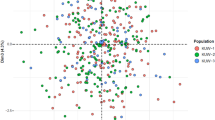Abstract
In order to apply a set of 14 short tandem repeat (STR) loci in parentage testing, we performed a population genetic study on a sample of 260 unrelated people from the Slovenian population. Genotypes for the 14 STRs were determined using three multiplex polymerase chain reactions (PCR) and automated fluorescent detection. The allele frequencies of the STR loci D5S818, D13S317, D7S820, D8S1179 and D18S51 showed no deviation from the Hardy-Weinberg equilibrium and agreed well with other Caucasian populations. We resolved a series of 181 parentage disputes of which 29 were exclusions. In all cases, evidence for exclusion was obtained by at least 4 informative STRs out of the 14 loci analysed. The 14 loci combined comprise a highly discriminating test suitable for paternity and identity testing in the Slovenian population, with an average estimated mutation rate of 1.2×10–3, a combined calculated power of exclusion of 99.99974% and paternity index (PI) value of >106 in 72% of the inclusion cases and >105 in 91% of the inclusion cases.
Similar content being viewed by others
Author information
Authors and Affiliations
Additional information
Received: 14 February 2000 / Accepted: 10 June 2000
Rights and permissions
About this article
Cite this article
Pajnič, I., Šterlinko, H., Balažic, J. et al. Parentage testing with 14 STR loci and population data for 5 STRs in the Slovenian population. Int J Leg Med 114, 178–180 (2001). https://doi.org/10.1007/s004140000179
Issue Date:
DOI: https://doi.org/10.1007/s004140000179




